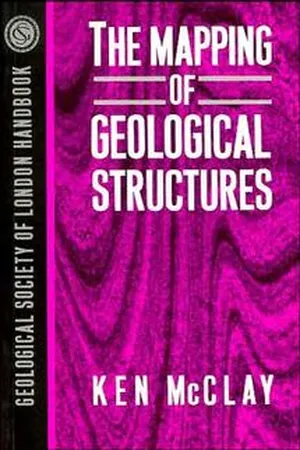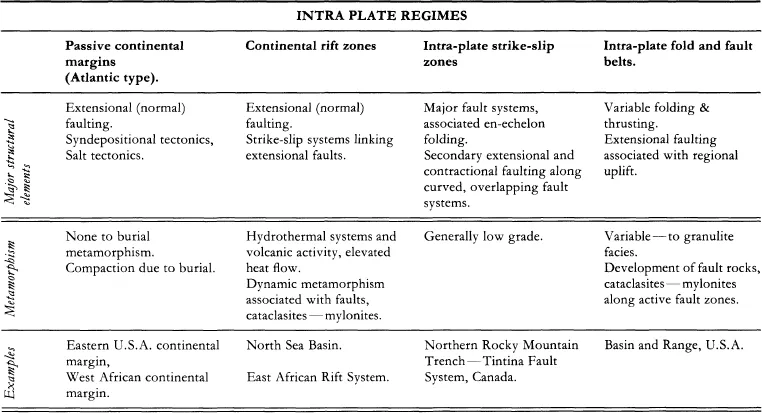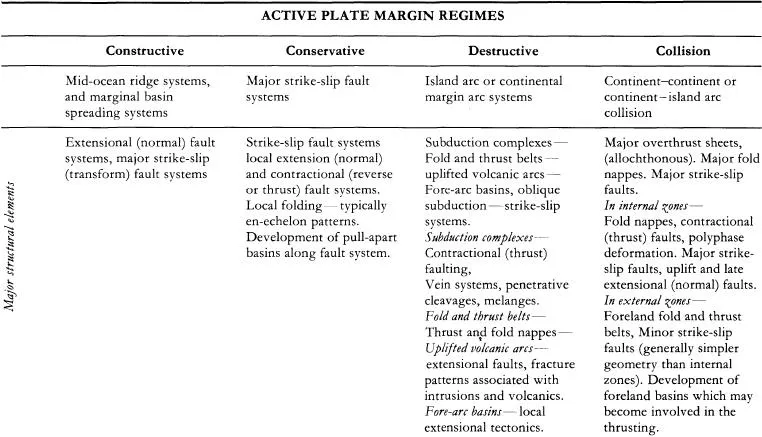![]()
1
Introduction
1.1 Objectives
This book is designed as a basic guide to the field mapping and interpretation of geological structures. Emphasis is placed upon the identification of structures and the systematic recording of structural data, as both should be a fundamental part of any mapping programme. The identification and description of structures, together with an understanding of their development, i.e. their movement patterns (Kinematic analysis) and an appreciation of the forces and stresses responsible for them (Dynamic analysis) are extremely useful for interpreting particular structures, and for knowing what geometry to expect whilst mapping in a particular terrane.
Structural data cannot be recorded or used in a vacuum. They must be accompanied by full lithological, sedimentological, petrological and palaeontological descriptions for their complete interpretation.
The following aspects are emphasised in this Handbook;
1 Recognition of structures.
2 What to measure and what to describe.
3 How to analyse the data collected.
4 How to interpret the data and incorporate it into the stratigraphy, interpretation and regional syntheses for an area.
In all cases emphasis is placed upon systematic field observations, accurate measurements of the orientations of structural elements, careful recording of the data in the field notebook, sketching and photographing the structures, and analysis in the field using the stereographic projection. Above all, structural geology requires the appreciation of the three-dimensional nature of structures. Think in 3D and learn to extend your view of structures above and below the map sheet.
1.2 Fieldwork
The importance of careful, accurate and systematic fieldwork cannot be overemphasised. Basic geologic mapping techniques are described in Barnes (1981), and the field descriptions of sedimentary, metamorphic and igneous rocks are outlined in the companion Handbooks by Tucker (1982), Fry (1984), and Thorpe and Brown (1985) respectively.
This Handbook describes the field techniques for mapping geological structures and for the identification and mapping of particular types of structure. It also gives a brief summary of the interpretation and analysis of structures.
Remember the following points:
1 Accurate measurement, observation and recording of all structural elements is essential. Avoid data selection in the field, otherwise you may find that upon further interpretation in the laboratory, you have failed to measure a key structural feature.
2 Carry out an ongoing interpretation whilst in the field (draw sketch cross-sections and maps). This will help you recognise key areas where further work may be necessary. Your interpretation will be governed by your experience and knowledge of regional structure, but only accurate and well-recorded data will have a permanent value and permit continuous reinterpretation.
3 Data should always be plotted on maps and cross-sections whilst in the field. Only in these circumstances can an effective, ongoing interpretation be achieved.
4 Structural data must be collected in conjunction with other lithological, petrological and palaeontological data.
Conduct and safety in the field
Fieldwork frequently puts geologists in hazardous situations. Structural geologists commonly work in rugged and exposed terrain where 3D exposure is good. Be safety conscious and aware of the possible dangers, particularly from loose rock underfoot, and from rock falls. Barnes (1981) outlines fieldwork safety, and in addition to reading this the reader should also consult the safety checklist on p. 16 of this Handbook before commencing fieldwork. Always carry out fieldwork in compliance with the Geologists’ Association Code of Conduct (see Barnes, 1981).
1.3 Tectonic and structural regimes
It is beyond the scope of this Handbook to describe regional structural relationships in detail, but it is useful to identify the dominant features associated with particular tectonic settings, as they provide a useful guide to the structures that may be found whilst mapping (Table 1.1). Characteristic families of structures may be expected to occur in a particular environment, e.g. shallow thrust faults and parallel folding in frontal regions of foreland fold and thrust belts, and this knowledge can greatly aid any ongoing interpretation. Table 1.1 is neither exhaustive nor exclusive in its contents and you should always be prepared for other structures to occur and record all the structural information from the outcrops in your mapping area.
Table 1.1 Structures associated with particular tectonic regimes.
1.4 Bedding
In sedimentary and many metamorphic rocks, bedding surfaces (surfaces of primary accumulation) are our principal reference frame (or datum). There are many possible bedforms in sedimentary sequences (see Tucker, 1982 for details) and the structural geologist must be aware that significant departures from layer-parallel stratigraphy can occur in certain sedimentary environments, e.g. deltas; thus structural data must always be collected in conjunction with sedimentological and stratigraphic data.
Bedding is one of the most important structural elements and the structural data that should be collected for bedding are outlined in Table 1.2. The spatial distribution of bedding or compositional banding (e.g. ingneissic terranes), will define the major fold and fault structures within your mapping area.
1.4.1 Way-up/younging and facing
Way-up/younging is the direction in which stratigraphically younger beds/units are found. (The term tops is also sometimes used in this context.)
The stratigraphic way-up is of fundamental importance in determining the structure of an area. It is based upon a knowledge of stratigraphy and of small-scale sedimentary structures which indicate the stratigraphic way-up and the sequence of deposition. Sedimentary structures which indicate way-up are discussed in Tucker, 1982 and are summarised in Fig. 1.1. Always look for and record way-up features when mapping.
The structural way-up refers to the bedding/cleavage relationships that indicate the position within a major fold structure (e.g. on the overturned limb of a recumbent fold). This may have no relationship to stratigraphic way-up. Take care to distinguish the two — see Chapter 3 for greater detail.
Facing is the direction within a structure i.e. along the fold axial plane or cleavage plane, in which younger beds/units are found. This term is generally applied to folds, or cleavage relationships.
1.5 ‘Synsedimentary’ versus tectonic structures
In many areas of deformed sedimentary rocks it is difficult to distinguish between structures formed during deposition or early diagenesis when the sediment was unconsolidated, and those formed after lithification in response to tectonic forces. On cursory examination many ‘synsedimentary’ structures such as slump folds have superficial geometric similarities to ‘tectonic’ folds (Fig. 1.2a). Syndepositional faults are also common (Fig. 1.2b) and in some instances syndepositional cleavage fabrics have been observed (Fig. 1.2c). It is the...



